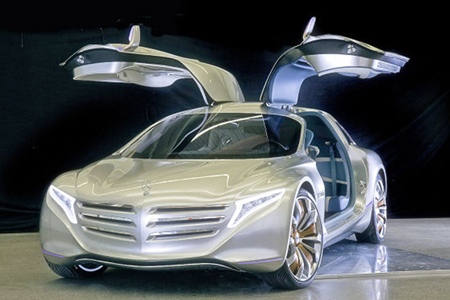According to Mercedes-Benz, their car of the future will have emissions-free hydrogen motoring with cloud computing, 3D displays and partially running on Auto-pilot.
The F125 concept – named to celebrate the 125th anniversary of the Daimler-Benz company, also integrates with the social media of 2025, making this car your complete mobile city office.
The styling as portrayed in this model is futuristic with gullwing doors and uses much in the way of lightweight materials to give the hydrogen car a 1000 km driving range. The car of the future also talks to the driver, with voice, touch and gesture controls as well as the ability to remotely control settings and entertainment features.
 Mercedes F125 Concept
Mercedes F125 Concept
The cloud computer control system is always connected to the internet (so it can’t be used in Thailand!), allowing users to access websites, information and entertainment, including photo albums and music libraries housed on servers.
The front passenger gets a 17 inch display that can be controlled by gestures rather than having to push a button or twiddle a knob, however I wonder what the M-B computer would make of a couple of raised fingers in a V shape?
Primary safety features are embodied in the car with electronics to provide advanced crash avoidance systems, which can interface with traffic lights and transport centers to warn the driver of obstacles or potential incidents at intersections.
The power will be supplied by a hydrogen fuel cell, which emits no carbon dioxide to make it a zero emissions vehicle, while at the same time the fuel cell performs a chemical reaction to create electricity to drive the electric motors. M-B does not consider that it will be necessary to have back-up or hybrid power. Hydrogen storage integrates the tanks in the structure of the car, allowing the manufacturer more freedom in their placement.
The batteries will be new generation lithium-sulphur batteries – claimed to hold more charge per kilogram than other batteries, bringing weight reductions – allowing the car to be recharged via induction pads and driven for up to 100 km just on the batteries, without the output from the hydrogen fuel cell. Peak power is 230 kW and 170 kW can be delivered constantly, which is enough to produce acceleration times of 4.9 seconds for the zero to 100 km/h sprint from the four electric motors housed near each wheel.
“With the F125 we want to show that large, comfortable and safe saloon cars have an excellent future, partly because they are able to operate with no emissions,” said Professor Dr Thomas Weber, member of the board of management of Daimler.
“The legend of the S-Class will continue into the future thanks to intelligent solutions that always have the customer’s needs in mind. The new research vehicle illustrates and underlines this claim to leadership with innovative ideas and traditional Mercedes strengths in the areas of design, safety, comfort and performance.”




